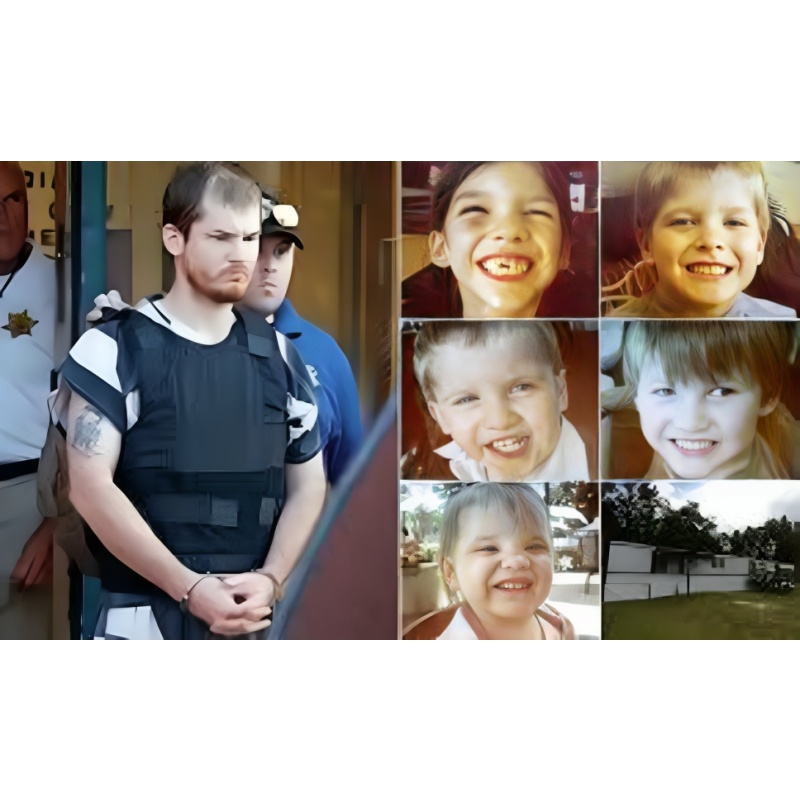TIMOTHY RAY JONES JR. | Killer Daddy | Dad who murdered his FIVE young kids after son said he wanted to live with mom wants death penalty scrapped because prosecutors were shown photos of his victims' bodies
LongfellowSerenade 27
Timothy Jones Jr. (born December 28, 1981 | age 42) is an American murderer who killed his five children: Merah, Elias, Nahtahn, Gabriel, and Abigail Elaine, in their mobile home along South Lake Drive in Lexington County, South Carolina. Jones admitted to working Nahtahn to death and killed the other four children in a panic. Jones pleaded not guilty by reason of insanity, but the court rejected this plea. He was found guilty of five counts of murder in 2019 and was sentenced to death. As of 2023 he is awaiting execution on death row in South Carolina. The South Carolina Supreme Court denied his appeal.
The voices start going off and then here comes the paranoia. "Oh shit" ... what just happened ... what just happened?"
And I followed suit with the other 4.
$20.00
- Postage
-
$0.00 to United States
Standard Shipping
Get Additional Rates
- Select Country
- Zip/Post Code
- Quantity
Description
Timothy Jones. Autographed Letter, Signed. Handwritten, Commercial #10 (4.125 × 9.5 envelope). Columbia, SC. Pmk: September 13, 2023. Content unknown. SEALED.
A South Carolina dad who murdered five of his children is seeking a new trial and to have his death penalty scrapped because jurors were shown autopsy photos of his victims' decomposing remains.
Lawyer Robert Dudek, defending Timothy Jones Jr, 37, in front of South Carolina's Supreme Court on Tuesday, argues that the shocking photos of the children's decomposing bodies in garbage bags were entered as court records at the last moments of the trial just to unsettle jurors.
Dudek says the grim autopsy snaps – which were given to jurors in an envelope so they the option to look at them – unfairly stacked the sentencing against Jones, who Dudek says is schizophrenic.
He also argues that prosecutors didn't properly explain what would happen if Jones was found not guilty by reason of insanity. Lawyers for Jones say it should have been explained that the killer wouldn't have been immediately released on such an acquittal, and could still have spent the rest of his life behind bars.
He, as well as other defense lawyers, want Jones' 2019 conviction on five counts of murder and death sentence overturned.
The images were taken nine days after children Mera, 8, Elias, 7, Nahtahn, 6, Gabriel, 2, and Abigail, 1, were killed 'by means of strangulation and/or other violent means or instruments' in 2014 and Jones tried to hasten their decomposition with sulfuric acid before they were found in garbage bags in Alabama.
'I've done this for over 30 years and those are about impossible to look at. They are horrific under any definition. Here you have 12 jurors off the street seeing photographs of dead children,' said Dudek, who is chief appellate defender for the South Carolina Commission on Indigent Defense.
Those photos weren't shown in court, as evidence usually is, sparking discussions over whether they were admissible, and whether any verdict they subsequently resulted in was a fair one.
Jones Jr' defense also said the case should be overturned because Circuit Judge Eugene Griffith refused to allow testimony from one defense expert witness, Dr. Flores, who planned to to rebut the testimony of Dr. Cruz on the state of Jones' mental health status and diagnosis of schizophrenia.
The evidence could potentially have spared Jones Jr the death penalty, Dudek said at the hearing, who pleaded not guilty by reason of insanity.
His defense argues that he didn't know right from wrong either morally or legally at the time because his brain was broken by undiagnosed schizophrenia amplified by stress from a failed marriage and struggling to raise his children alone.
In court on Tuesday, justices asked solicitor Rick Hubbard, who was making a rare appearance by a trial prosecutor before the state's highest court, to justify his own actions in Jones' trial, why he asked to include the photos.
In 2019, Hubbard told the jury he had left pictures of the children's decomposition in the jury room after having Dr. Janice Ross testify in grim detail to the conditions of their bodies — including saw marks on Jones' 2-year-old son's leg — and what he had done to try and hasten their decomposition. Jones used acid to try and dispose of the children's remains.
'The way he treated those bodies with contempt. We had Dr. Ross say here was a disarticulated leg, referring to bag three with Gabriel, the 2-year-old,' Hubbard answered. 'But you had to look to see what she meant.'
Before Hubbard spoke, Associate Justice John Kittredge wondered aloud why the prosecutor risked what appeared to him to be an airtight case.
Kittredge then cited a 2010 ruling by the state Supreme Court where they warned prosecutors that submitting photos of a Spartanburg couple who were beaten to death and burned by a man pushed the outer limits of what judges should allow.
'Stop it! Stop this nonsense,' Kittredge said. 'The pathologist testified in great detail as to what the pictures depicted, but we just got to throw the autopsy pictures in there to stir the pot. I don't know what it is going to take to stop this.'
Court precedents normally give latitude to defense efforts to mitigate, or substitute a life sentence, for the death penalty, justices said at the hearing.
Associate Justice John Kittredge noted that, year after year, the U.S. Supreme Court has made it clear that 'mitigation evidence in a capital sentencing proceeding is 'broad and expansive.'
'That's not what happened here,' Kittredge said.
You're absolutely right,' Senior Assistant Deputy Attorney General Melody J. Brown said. 'There is Supreme Court precedent that says there is a broad path. But it is not unlimited.'
Regarding his decision not to show the shocking photos of the children in garbage bags in front of an open court, Hubbard argued that he previously learned that jurors lose trust in a prosecutor when he shows them horrific photos on his terms.
That's why Hubbard said he told them in his closing statement if they needed further proof, the envelope with the photos was in the jury room and 'if you have any doubt for the appropriate sentence for that man, look in the bag!'
'They get offended at me when I hold up photos that are hard,' Hubbard said. 'So I let them do it on their time.'
It is unclear when a ruling will be reached, and the justices only said that they will rule at a later date.
Jones Jr killed his five children, ages 1 to 8, in their Lexington home in August 2014. He had full-custody of them after divorcing his wife of ten years.
Prosecutors said after he killed his 6-year-old son, Nahtahn, for defiance, he decided to kill the rest of the family to cover up the crime. Jones Jr said his motive behind the murders was that he believed his children planned to kill him and then 'chop him up and feed him to the dogs,' according to his arrest warrant.
Jones Jr then drove around the Southeast with their bodies for nine days before dumping them in garbage bags on the side of an Alabama dirt road near Camden.
He was subsequently stopped in Raleigh, Mississippi on suspicion of driving under the influence. The children were not with him and there was blood in his vehicle.
South Carolina's social services officials visited Jones' home three times to investigate conditions in the the three years preceding the deaths.
'Jones appeared overwhelmed in caring for his children after his 10-year marriage ended in divorce in October 2013,' read the DSS report filed shortly before the Jones children were killed.
The photos were just one of a half-dozen reasons Jones' lawyers want his conviction and sentence tossed out. They also said a judge should have told jurors that being found not guilty by reason of insanity didn't mean Jones Jr would walk out of the courthouse a free man.
Instead, he would be kept in custody for several months or up to the rest of his life if his mental condition never improved.
Attorneys for Jones Jr said a judge should have also allowed jurors to see a videotape of Jones' mother, who had been ordered to remain in an out-of-state mental hospital for decades because of her schizophrenia, a diagnosis her son was aware of and made him angry and nervous.
But much of the arguments Tuesday centered around the photos of the dead children. Defense attorneys tried to show them to the jury before they found Jones Jr guilty, saying the condition of the bodies helped show he was insane. Prosecutors objected, and the judge agreed.
Dudek said the defense lawyers also figured prosecutors would wait and use the photos in final moments before the jury started deliberating whether Jones Jr should die for his crimes and wanted to lessen their impact by using them earlier in the trial.
VIDEO: Timothy Jones Jr.: Killer Daddy – Prime Crime – A&E | https://youtu.be/I1ugWESnvBY
VIDEO (podcast): Monsters S01E01: Timothy Jones Jr. | https://youtu.be/jxv7p2SI3e8
Archiving Protocol:
• Handled with White Gloves ab initio
• Photo Pages/Sheet Protectors: Heavyweight Clear Sheet Protectors, Acid Free & Archival Safe, 8.5 × 11, Top Load
• White Backing Board—Acid Free
Shipping/Packaging: Rigid Mailer 9.5 × 12.5. White, self seal, stay flat, kraft cardboard, no bend. Each rigid mailer is made of heavy cardboard, which has strong resistance to bending and tearing. Thicker that the USPS mailers. Shipping cost never more than it absolutely has to be to get it from me to you.
Payments & Returns
- Payment Methods
- PayPal, Money Order
Postage & Shipping
- Item Location
- 54911, Wisconsin, United States
- Ships To
- Worldwide
- Pick-ups
- No pick-ups
- Returns Accepted
- No







